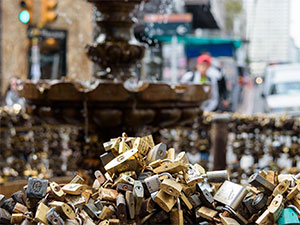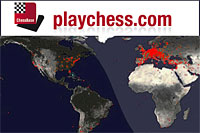
The tournament
The tournament is an eleven-round competition played at 40 moves in 90 minutes followed by 30 minutes for the rest of the game and a 30-second increment as of move one. The first round is on May 15 with rounds every day until round eleven on May 24, including a double-round on May 17. Play typically starts at 5PM.
Although there are tiebreak scoring systems in place, starting with direct encounter, Buchholz, and more, in the event of a draw at the top, the top four qualifiers will be decided by a rapid tiebreak match or tournament, depending on the number, starting at 15 minutes plus a ten-second increment.
The prizes are US$5000 for first, $3400 for second, $2400 for third with prizes all the way to 20th place. Note that as FIDE events of this caliber, all norms scored count double, thus a player who scores a norm at the end of the competition will be considered to have earned two norms, not one.
The people and 'mate'
If you read the title and thought of mate as in check mate, you will be quickly forgiven, the word is in fact pronounce ‘Mah-teh’. Typical of the entire region encompassing the deep south of Brazil, as well as Uruguay and Argentina (and more), mate is a national passion and tradition that is hard to explain to an outsider.
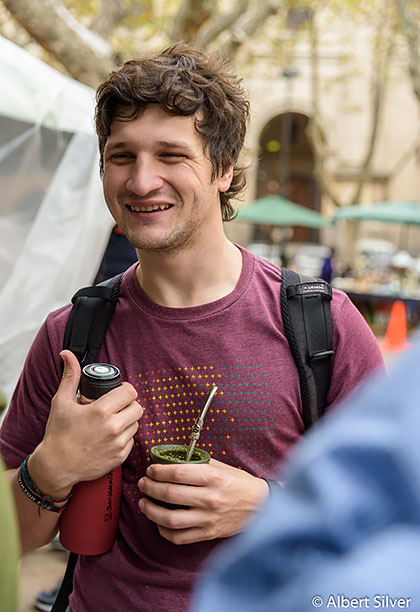
This is mate (mah-teh). It is a green herb drunk as a tea. I know, I know,
you took one look at that odd bowl with a metal straw and though these
were a bunch of reefer addicts, but nothing could be further from the truth.
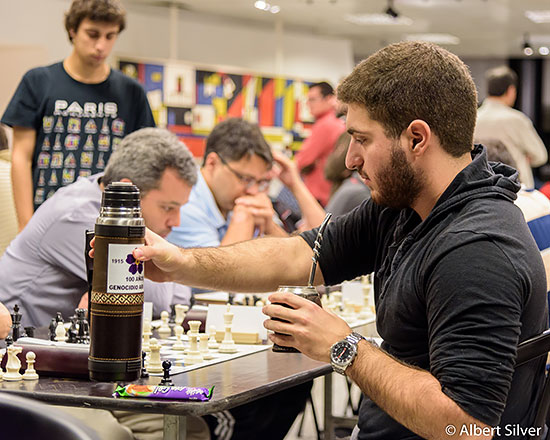
It is an infusion drink, in which the gourd is filed with the herb and hot water is poured into
it, producing a pleasant caffeine rich tea, that is consumed via the metal straw, also known
as the 'bombilla'. In Uruguay the tradition is so deeply etched into the society, that men are
seen everywhere with a small thermos of hot water under their arm with the gourd.

Even at the tournament hall, Uruguayan men were seen with this at the tables, as can be seen
above with two men touting their cherished gourds. I must admit that having grown up on a diet
of Asterix and Obelix comics as a child, I can't help thinking of the gaulish 'magic potion' whenever
the word gourd comes up. Contrary to many teas, which can often be bitter, this is quite pleasant.

This little leather bag is one player's way of carrying his 'mate' kit
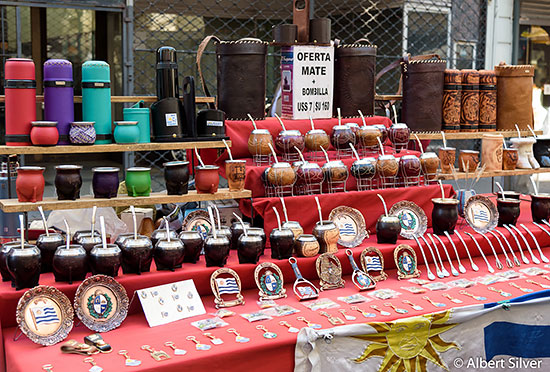
Almost all street vendors carry a wide variety of gourds and bombillas, knowing they are easy sales

In the Museum of Currency, there was a display of fancy and old gourds that had us intrigued at first
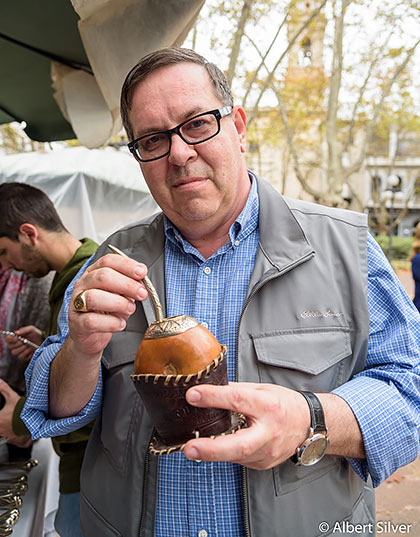
A new convert to Mate, Yermo?

Although I could not help but stop midway from crossing the street to
take this picture, this image is actually quite representative of the people
in Montevideo. They love their dogs and raise and take care of them with
overt affection. (click image for high-res version)
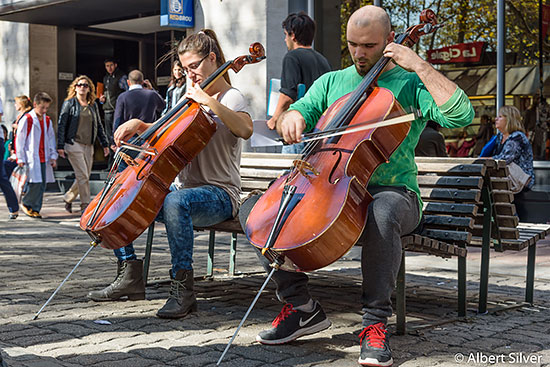
Naturally, buskers are nothing unusual, but cellist buskers are not exactly your everyday occurence
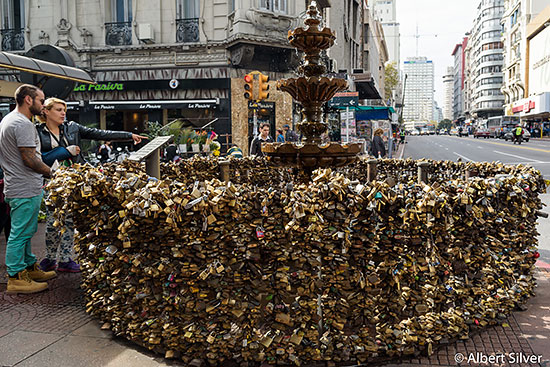
This slightly unusual sight is a theme that is used in many places: the Locks of Love

The sign explains the principle: the lock with the initials of the lovebirds will seal their passion
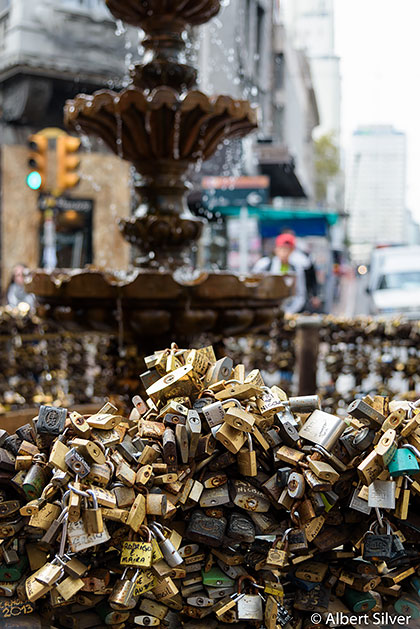
Locks upon locks, upon locks. Such passion!

From the building of the playing hall, I went to the 26th floor to see the city and it was more
than a little impressive. What a magnificent port! (click image for high-res version)
Round ten
After so many rounds, and so many leaders, it was the true clash of the titans, as two of the players whose form had shone throughout, finally met head to head. The image of two rams with their heads lowered, racing across a field on a collision course is completely appropriate.
Jorge Cori who was sole leader on more than one occasion, showing great form, and Argentine Sandro Mareco, who caught up with him near the end, fought a fantastic game worthy of the prestige and significance of their bout.
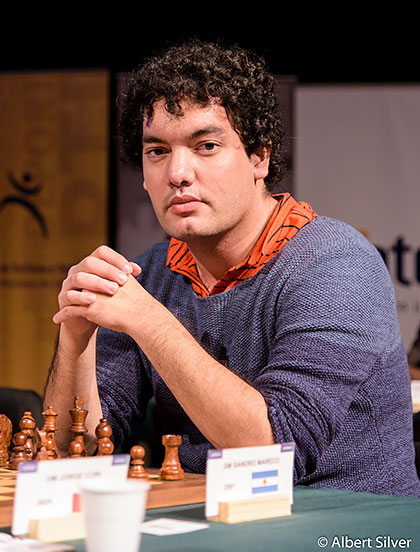
Sandro Mareco was not to be denied and showed great character and skill
As IM Luis Rodi describes it: "A new change in the tournament leadership. One round before the last, the Argentine grandmaster Sandro Mareco is the player with the most points, after defeating his Preuvian colleague Jorge Cori, the previous leader. The competition has been characterized but the constant changes in the top spot, and no.1 seat has been almost an electric chair for any bold enough to try and sit in it too long".
GM Jorge Cori - GM Sandro Mareco (annotated by IM Luis Rodi)

[Event "Continental"] [Site "Montevideo"] [Date "2015.05.23"] [Round "10"] [White "Cori, Jorge"] [Black "Mareco, Sandro"] [Result "0-1"] [ECO "E05"] [WhiteElo "2609"] [BlackElo "2581"] [Annotator "Rodi,Luis"] [PlyCount "90"] [EventDate "2015.05.23"] [EventCountry "URU"] 1. Nf3 Nf6 2. d4 e6 3. g3 d5 4. Bg2 Be7 5. O-O O-O 6. c4 dxc4 7. Qa4 (7. Qc2 { could transpose, however in the event of} a6 {White could choose 8.Qxc4 transposing, or might also opt for} 8. a4 {that is a recommendation by Boris Avrukh in his recent book on a white repertoire with 1.d4, which revolved around the Catalan.}) 7... a6 8. Qxc4 b5 9. Qc2 Bb7 10. Bd2 Be4 11. Qc1 c6 {A move that has been quite popular at the highest levels, popularized by Rozentalis.} ({Naturally, in virtue of the tournament situation, has no interest in repeating the moves with} 11... Bb7 12. Qc2 Be4) 12. Rd1 ({In the seventh round, Mareco, playing white, chose the more common} 12. Be3 {and after } Nbd7 13. Nc3 Bg6 14. Bg5 $146 Rc8 15. Rd1 Nd5 16. Bxe7 Qxe7 17. Qd2 b4 18. Na4 c5 {the game Mareco - Perez Ponsa, Montevideo 2015 ended in a draw.}) 12... Nbd7 13. Nc3 Bg6 14. Bg5 $5 ({Another possibility was} 14. a3 Nd5 15. b4 $5 Bf6 16. Be1 Rc8 17. Ra2 Qb6 18. e3 Qa7 $11 {Ding Liren - Jumabayev, Tabriz 2014}) 14... Rc8 15. a3 $146 {As seen in the previous note, this move is thematic. The problem is that it does not work in combination with a Ne5 and white was better off playing Ne5 immediately without 15.a3.} (15. Ne5 Nxe5 16. dxe5 Nd5 17. Bxe7 Qxe7 18. a4 Rfd8 $11 {Ponfilenok - Lysyj, St Petersburg 2012}) 15... h6 $1 16. Bxf6 Bxf6 17. Ne5 $6 {Black gains an edge now as the exchange on e5 will not only double the pawns on the e-file, but secure a queenside 3-2 majority.} ({Better was} 17. Qe3 Nb6 18. Ne4 Bxe4 19. Qxe4 Na4 $5 {with a roughly equal position.}) 17... Bxe5 18. dxe5 Qc7 19. f4 {The follow-up to White's previus move, but Black's knight maneuver will secure an advantage for the second player.} (19. Ne4 Bxe4 20. Bxe4 Qxe5 21. Qe3 Qc7 $15 {White scarcely has any compensation for the pawn deficit.}) 19... Nc5 $1 20. Qe3 Nb3 $17 {It is quite possible that Cori underestimated the strength of this knight move, considering its loneliness in the enemy camp. However, the move has a devastating effect on White's piece coordination.} 21. Ra2 Rfd8 $1 {Pure technique. Black is trading off White's only active pieces, keeping him off-balance.} 22. Kf2 Rxd1 (22... a5 $5 {is the computer's suggestion.}) 23. Nxd1 Bc2 $1 {One more piece in White's camp} 24. Nc3 Qd7 25. Be4 (25. Ne4 {was the best attempt. After} Bxe4 26. Bxe4 Qd1 27. Qd3 {Otherwise ...Nd2 or ...Rd8 were very strong.} Qxd3 28. Bxd3 c5 {and Black's chances are to be preferred due to the relative pawn structures.}) 25... Bxe4 26. Nxe4 Qd1 27. a4 Nc1 28. Ra3 b4 29. Ra1 Nd3+ 30. Qxd3 Qxa1 {Black has finally won material for his efforts, but White's good piece position ensures some counter play now.} 31. b3 a5 32. Qd7 Rf8 33. Qxc6 Qd4+ 34. Kg2 Rd8 35. Nd6 Qc3 36. Qf3 (36. Qb7 Rf8 37. Qf3 {would be more resistant.}) 36... Rd7 37. Qa8+ Kh7 38. Qe4+ g6 39. Qa8 (39. Ne8 Ra7 $17) 39... Qe3 40. Qc6 $2 (40. Qf3 Qxf3+ 41. Kxf3 Rc7 $17) 40... Qxe2+ 41. Kh3 Ra7 42. Qc5 Qf1+ 43. Kh4 Qg2 44. Kg4 Rd7 45. Qc8 Rxd6 $1 {No caso de 46.Dc7 as pretas ganham com 46...De2+ 47.Rh3 Dh5+, e a tomada de torre se responde com 46...f5+ com mate no seguinte lance} (45... Rxd6 {In case White tried} 46. Qc7 $5 {with the idea of attacking the rook as well as threatening Qxf7+ with a perpetual. Black would win with} ({As to} 46. exd6 {Black mates with} f5+ 47. Kh4 Qxh2#) 46... Qe2+ 47. Kh3 Qh5+ 48. Kg2 Rd2+) 0-1
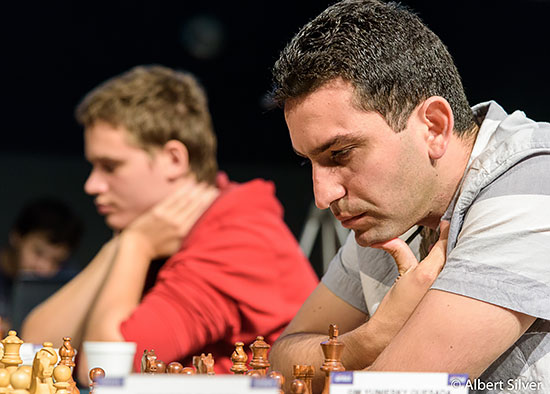
Second-seed Yuniesky Quesada Perez from Cuba drew his game against Diego Flores
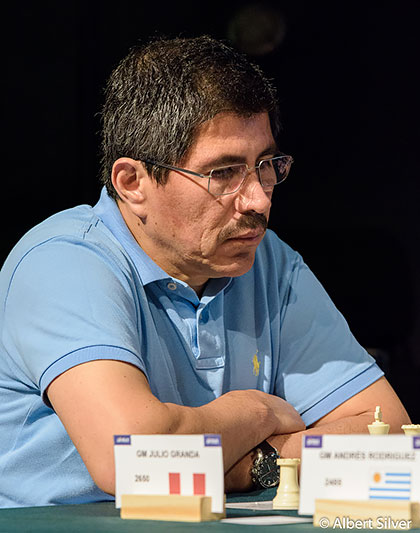
GM Granda Zuñiga had an up-and-down tournament, though beat
local GM Andrés Rodrigues in round ten
However, it was also a day of deepest black for Brazilian fans. Granted none of those playing were clear favorites in the top contentions, though Rafael Leitão is already qualified for the World Cup, there was every reason to believe at least an important norm would be earned. Players such as IM Yago Santiago, who had started with 4.0/4, or IM Diego Di Berardino seemed certain of a GM norm, but it wasn’t to be and round ten saw a dismaying series of losses by all the hopefuls.

GM Krikor Mekhitarian was hoping to earn a spot in the World Cup, but ran into a brick wall
as he was gunned down by WGM Deysi Cori in a dramatic game
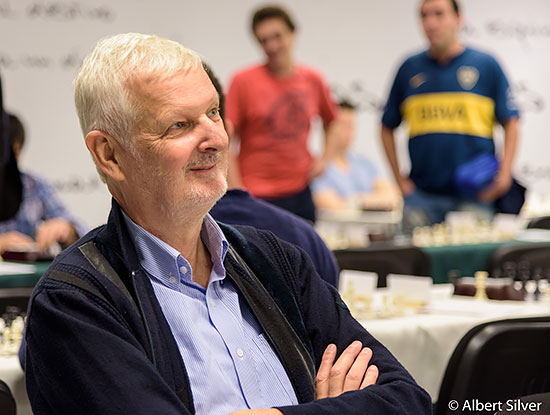
By the most curious alignment of the stars, veteran IM Herman Claudius Van Riemsdijk was
the Brazilian player with the most points. Though the three-time Brazilian champion, and 30-time
national finalist was quick to dismiss it with a wave of the hand: way to go Herman!

Untitled Peruvian Brian Escalante (2373) is clearly here for the norm

After an extensive layoff from the game, Carlos Eduardo Valente has held his own
Standings after ten rounds
Click for complete standings
The top eight boards of the event can be followed live at both the official site and on Playchess.
All photos by Albert Silver
